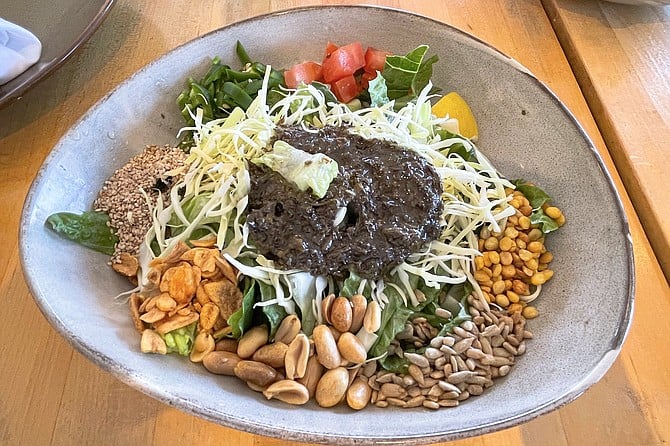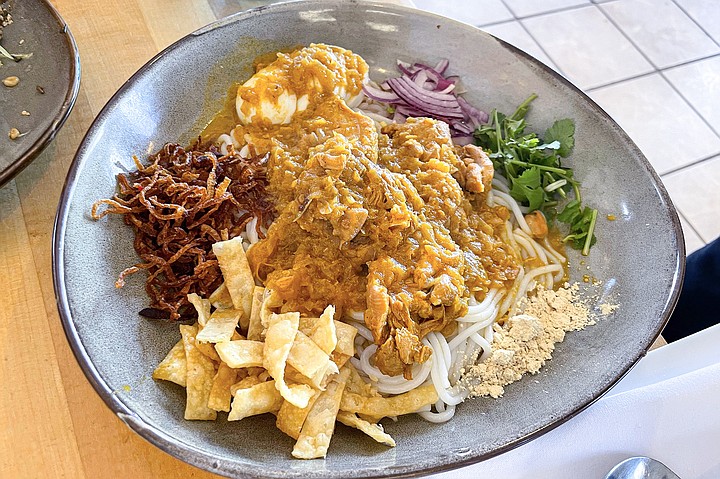 Facebook
Facebook
 X
X
 Instagram
Instagram
 TikTok
TikTok
 Youtube
Youtube

The last time I tried Burmese food, I had to drive hours to get it. But on this sunny afternoon, the car only has to make it as far as Rancho Bernardo. Still, I’m impatient all the way there, practically giddy about all the dishes I want to try. And, unlikely as it sounds, the one I’m most excited about is a salad.
With the arrival of Burma Place, San Diego finally has a Burmese restaurant. Our county is blessed with such far-ranging culinary diversity, it can be hard to notice which cultures are yet absent. And food representing the nation now known as Myanmar possesses a low profile in the U.S., relative to the other countries of Southeast Asia. On the West Coast, the best place to find Burmese food is the San Francisco Bay area, and that’s where the experienced restaurateurs behind Burma Place came from, to show us what we’ve been missing.

And what I’ve been missing is the tea leaf salad, lahpet thoke (pronounced something like la-pay toe), which owes its distinctive flavors to fermented green tea leaves. You may not be surprised to learn that fermenting tea leaves doesn’t make them more beautiful: it results in a sort of slimy, dark green preserves. However, that doesn’t inhibit a lovely presentation of the $16 tea leaf salad that arrives at my table.
In the center of the bowl, fermented green tea tops a heap of shredded cabbage, which sits upon a bed of chopped romaine lettuce. Eight ingredients encircle the cabbage, each separated into its own pile. There are diced tomatoes and jalapeños, and a slice of lemon, but most of them are crispy: peanuts, garlic chips, sunflower seeds, sesame seeds, and fried yellow lentils. Along with the mildly floral, umami richness of the tea leaves, it’s the overlapping, crunchy textures that make the thing unforgettable.

This one does not disappoint. I may never again say this about a salad, but consider it a must-try dish.
A server mixes the salad at our table, the professed goal being that every ingredient be in each bite. And this style of presentation turns up again during our meal. Myanmar’s food may best be understood by looking at the country’s geography: it’s surrounded on three sides by the likes of India, China, and Thailand.
Influences of each culture are more or less apparent in the dishes populating Burma Place’s menu. Appetizers include samosas as well as lettuce wraps, and crispy chicken wings. There’s also Shan tofu ($10), which is a sort of fried tofu, except derived from yellow lentils rather than soybeans. These are crispy, orange wafers with a soft, almost creamy center.

You’ll find examples of Burmese-style chow mein, plus fried plates of sesame and sweet-and-sour chicken. There are stir fries featuring mint or mango, some featuring chili peppers, and others that employ fish sauce. There are kabocha squash stews, and there are plenty of curries, some spicy, and some sweetened by coconut milk. For any omnivore, I can recommend the vegetarian eggplant curry, braised tender in a gingery Burmese curry ($13), which I found milder than most Indian curries, and less spicy/sweet than many Thai curries. The eggplant here actually holds its own well.
One of the more interesting examples is nan gyi thoke ($14), which puts a coconut chicken curry over rice noodles, and garnishes them with hard-boiled egg, fried onions, wonton chips, cilantro, and pea powder. There aren’t enough noodle curries in the world, in my opinion, and this dish (also mixed at the table) satisfies cravings I didn’t know I had. Like Burmese food itself.


The last time I tried Burmese food, I had to drive hours to get it. But on this sunny afternoon, the car only has to make it as far as Rancho Bernardo. Still, I’m impatient all the way there, practically giddy about all the dishes I want to try. And, unlikely as it sounds, the one I’m most excited about is a salad.
With the arrival of Burma Place, San Diego finally has a Burmese restaurant. Our county is blessed with such far-ranging culinary diversity, it can be hard to notice which cultures are yet absent. And food representing the nation now known as Myanmar possesses a low profile in the U.S., relative to the other countries of Southeast Asia. On the West Coast, the best place to find Burmese food is the San Francisco Bay area, and that’s where the experienced restaurateurs behind Burma Place came from, to show us what we’ve been missing.

And what I’ve been missing is the tea leaf salad, lahpet thoke (pronounced something like la-pay toe), which owes its distinctive flavors to fermented green tea leaves. You may not be surprised to learn that fermenting tea leaves doesn’t make them more beautiful: it results in a sort of slimy, dark green preserves. However, that doesn’t inhibit a lovely presentation of the $16 tea leaf salad that arrives at my table.
In the center of the bowl, fermented green tea tops a heap of shredded cabbage, which sits upon a bed of chopped romaine lettuce. Eight ingredients encircle the cabbage, each separated into its own pile. There are diced tomatoes and jalapeños, and a slice of lemon, but most of them are crispy: peanuts, garlic chips, sunflower seeds, sesame seeds, and fried yellow lentils. Along with the mildly floral, umami richness of the tea leaves, it’s the overlapping, crunchy textures that make the thing unforgettable.

This one does not disappoint. I may never again say this about a salad, but consider it a must-try dish.
A server mixes the salad at our table, the professed goal being that every ingredient be in each bite. And this style of presentation turns up again during our meal. Myanmar’s food may best be understood by looking at the country’s geography: it’s surrounded on three sides by the likes of India, China, and Thailand.
Influences of each culture are more or less apparent in the dishes populating Burma Place’s menu. Appetizers include samosas as well as lettuce wraps, and crispy chicken wings. There’s also Shan tofu ($10), which is a sort of fried tofu, except derived from yellow lentils rather than soybeans. These are crispy, orange wafers with a soft, almost creamy center.

You’ll find examples of Burmese-style chow mein, plus fried plates of sesame and sweet-and-sour chicken. There are stir fries featuring mint or mango, some featuring chili peppers, and others that employ fish sauce. There are kabocha squash stews, and there are plenty of curries, some spicy, and some sweetened by coconut milk. For any omnivore, I can recommend the vegetarian eggplant curry, braised tender in a gingery Burmese curry ($13), which I found milder than most Indian curries, and less spicy/sweet than many Thai curries. The eggplant here actually holds its own well.
One of the more interesting examples is nan gyi thoke ($14), which puts a coconut chicken curry over rice noodles, and garnishes them with hard-boiled egg, fried onions, wonton chips, cilantro, and pea powder. There aren’t enough noodle curries in the world, in my opinion, and this dish (also mixed at the table) satisfies cravings I didn’t know I had. Like Burmese food itself.
Comments